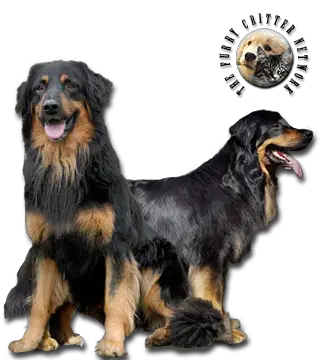Breed Standard
Head: Robust. Broad, arched forehead. Pronounced stop. Strong, long muzzle. Black lips.
Ears: Triangular, pendulous, hanging flat against the head.
Eyes: Oval. Dark or medium brown color.
Body: Muscular and streamlined. Powerful neck without dewlap. Broad, deep brisket. Straight, solid back. Croup slightly sloped.
Tail: Long, richly clad, reaching just below the hocks. Carried low at rest.
Hair: Long, coarse with slight wave. Short on the head and front of the legs. No streaking or curl. Little undercoat.
Coat: Fawn (blond) becoming lighter on the legs and abdomen. Black. Black and tan (most common) with fawn markings (above the eyes, on the chest, legs, and under the root of the tail). Each of the three varieties allows one small white spot on the forechest and mixture of a few lighter colored hairs, particularly on the tip of the tail.
Size: Dog: 63 to 70 cm Bitch: 58 to 65 cm
Weight: 30 to 50 kg
History
This old breed's name comes from the German word Hofewart, meaning estate dog, revealing his traditional role as guard dog for German farms in the thirteenth century. His distant ancestors were probably Asian mastiffs. Over the centuries, the breed was gradually abandoned. It wasn't until the 1920s that the breed was resurrected by crossing German Shepherds, Leonbergers, Newfoundlands, and others. The breed was recognized in 1936 and established as a utility dog by the FCI in 1964. Today, the Hovawart is quite popular in Germany and Scandinavian countries.
Behavior
In German, the word hovawart is accepted to mean “guardian of the hearth” or “guardian of the farm.” In either case, the breed was developed to protect and guard the German farmsteads and; consequently, the dogs were designed to bond very closely with their families. This makes them exceptionally good companions even when there is no need to guard. However, the owner should always be aware that the guarding instinct is there and will show up whenever the dog perceives there to be a threat.
Hovawarts, like all dogs, can be good with children if properly socialized. However, no child should be left unsupervised with any dog. Young dogs and young children are both in a state of learning and may not interact appropriately. Because of the size of a hovawart, small children may be knocked down by a playful act, or an unintentional collision. Because of their size and strength they may be difficult for a child to control. Care should always be taken to ensure the safety of both dog and child.
Hovawarts can be as large as 28 inches at the shoulder and weigh as much as 100 pounds or more. Therefore, the more running room they have, the happier they will be. It is preferable to have a large fenced yard, but substitute exercises such as hiking, trips to a dog park, etc. can make up for some lack in this area. Apartments are not typically large enough, or have room enough, for the desired activities.
Function
Herder, Utility Dog: rescue (avalanches), tracker (drugs), guide dog, guard dog, Pet.
Health
Hovawarts are quite healthy. One can expect an average lifespan in the 10 to 14 year range and owners should be prepared to dedicate this amount of time to their care. There are no known issues of breed specific diseases and hip dysplasia rates have been calculated at less than 5%. For a large breed dog, this is an exceptionally low rate.






